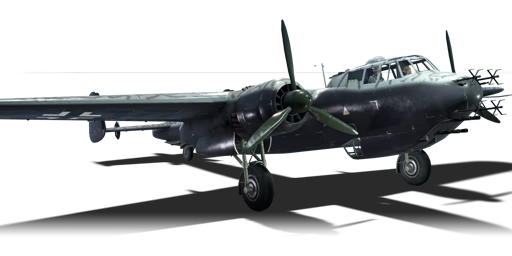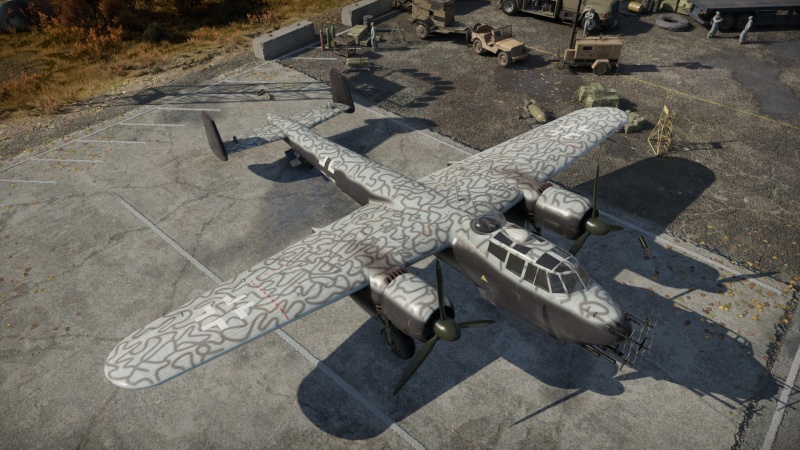Do 217 J-2
| This page is about the German twin-engine fighter Do 217 J-2. For other versions, see Do 217 (Family). |
Contents
Description
The Do 217 J-2 is a rank German twin-engine fighter with a battle rating of (AB), (RB), and (SB). It was introduced in Update 1.29.
Compared to its predecessor, the Do 217 J-2 is a more dedicated night fighter, with radar, a removed crew member to save weight, and no payload options.
General info
Flight performance
| Characteristics | Max Speed (km/h at 5,500 m) |
Max altitude (metres) |
Turn time (seconds) |
Rate of climb (metres/second) |
Take-off run (metres) | |||
|---|---|---|---|---|---|---|---|---|
| AB | RB | AB | RB | AB | RB | |||
| Stock | 450 | 434 | 34.4 | 36.1 | 4.2 | 4.0 | 750 | |
| Upgraded | 486 | 469 | 31.7 | 33.0 | 8.0 | 5.9 | ||
Details
| Features | ||||
|---|---|---|---|---|
| Combat flaps | Take-off flaps | Landing flaps | Air brakes | Arrestor gear |
| X | ✓ | ✓ | X | X |
| Limits | ||||||
|---|---|---|---|---|---|---|
| Wings (km/h) | Gear (km/h) | Flaps (km/h) | Max Static G | |||
| Combat | Take-off | Landing | + | - | ||
| N/A | 351 | 270 | ~6 | ~5 | ||
| Optimal velocities (km/h) | |||
|---|---|---|---|
| Ailerons | Rudder | Elevators | Radiator |
| < 290 | < 360 | < 360 | > 315 |
Survivability and armour
- 8.5 mm Steel - Fore-cockpit plate
- 8.5 mm Steel - Pilot's seat
- 50 mm Bulletproof Glass
- 8.5 mm Steel - Dorsal gunner's plate
- 5 mm Steel - Belly gunner's plate
- 8.5 mm Steel - Belly gunner's upper plate
- 5 mm Steel - Rear boom plate
- 5 mm Steel - Aft plate
Modifications and economy
Armaments
Offensive armament
The Do 217 J-2 is armed with:
- 4 x 20 mm MG FF/M cannons, chin-mounted (200 rpg = 800 total)
- 4 x 7.92 mm MG 17 machine guns, nose-mounted (700 rpg = 2,800 total)
Defensive armament
The Do 217 J-2 is defended by:
- 1 x 13 mm MG 131 machine gun, dorsal turret (500 rpg)
- 1 x 13 mm MG 131 machine gun, ventral turret (500 rpg)
Usage in battles
The Do 217 J-2 is identical to the Do 217 J-1 in most aspects but moved up in battle rating (besides Arcade). The increase in battle rating exacerbates the already subpar performance of the J-1. In terms of climb rate, turn rate, energy retention, and compression, the Do 217 J-2 is outperformed by almost every aircraft it will face, even some enemy bombers. However, the nose-mounted radar affords the J-2 unique opportunities compared to its predecessor.
In air battles, the radar is not extremely useful outside of Simulator battles, though it still has applications in Realistic mode when visibility is poor. Unidentified enemy aircraft within the radar's 4 km range will appear at their corresponding distances as a curved block segment, which can aid the pilot in preparing to attack unmarked enemies. Considering how early in the tech tree the Do 217 J-2 appears, it may be pilots' first encounter with radar, and it is important to note that the radar does not distinguish between friend or foe.
In combined battles (ground and naval), where enemy aircraft are completely unmarked, the radar can aid pilots in tracking down their prey. In ground battles, this is especially useful for hunting overzealous attack aircraft, as the battle zone is much more concentrated, reducing the weakness of the radar's short range. Common enemies like the IL-2 will bleed their energy after multiple attack passes, making them easy targets, even for the sluggish Do 217. Despite the IL-2's legendary durability, the frontal armament of four 20 mm MG FF/M cannons with air belts should not have trouble taking it down. Another advantage the Do 217 J-2 enjoys in combined battles is the lower altitude of the majority of combat, making its weak climb rate slightly less problematic.
The Do 217 J-2's flight characteristics are overall inferior to a large majority of its adversaries, so the pilot must exercise caution and patience before seizing the opportunity to attack. Pilots should avoid entering a fight alone if they can. Instead, this aircraft excels at exploiting enemies' moments of weakness. If the pilot has a partner in their squad, this is even better, as the two can coordinate their manoeuvres. An enemy aircraft that has been baited into the firing path of the Do 217 J-2 will soon regret their mistake.
Radars
The Do 217 J-2 is equipped with a FuG-202 search radar, located in the nose of the aircraft; a control box which is part of the radar damage model is located behind the pilot.
| FuG-202 - Target Detection Radar | |||
|---|---|---|---|
| Maximum Detection Range |
Guaranteed Detection Range |
Max Azimuth Scan Angle |
Max Elevation Scan Angle |
| 4,000 m | 4,000 m | ±30° | ±30° |
Manual Engine Control
| MEC elements | ||||||
|---|---|---|---|---|---|---|
| Mixer | Pitch | Radiator | Supercharger | Turbocharger | ||
| Oil | Water | Type | ||||
| Not controllable | Controllable Not auto controlled |
Not controllable Not auto controlled |
Controllable Not auto controlled |
Combined | Not controllable 2 gears |
Not controllable |
Pros and cons
Pros:
- Has access to a target detection radar
- Heavy nose-mounted armament with great accuracy and 1-second burst mass
- 20 mm cannons with deadly Minengeschoß rounds that can shred through enemy aircraft
- Rapid-firing 7.92 mm MG with a lot of ammunition
- Good coverage from the 13 mm rear gunners
Cons:
- Bad manoeuvrability: poor rate of climb and turn rate
- Poor energy retention and stability through turns
- Large, sluggish target
- Radar installation bleeds lots of speed
History
| Archive of the in-game description | |
|---|---|
|
Dornier Do 217 J-2 twin-engine night fighter When production models of a properly functioning FuG 202 Lichtenstein B/C airborne radar appeared, Do 217 J-2 variant night fighters began to be constructed. Planes of the J-2 variant differed from the J-1 in their lack of a rear bomb bay, which had finally been removed, and in the characteristic "whiskers" of their radar antennas which had appeared in the nose section. The new fighter failed to eliminate the main disadvantages of its predecessor. It was also notable for its low speed and poor manoeuvrability. After radar antennas were installed, the aircraft's aerodynamic resistance was significantly increased, which reduced its already low maximum speed. But now the presence of an airborne radar enabled the fighter crew to detect enemy planes on their own and prepare for an attack in advance. In addition to the radar, the plane's radio electronic equipment included a FuG 10 short-wave radio set and a radio altimeter of a FuG 101 (with a height measurement range of 0 to 1,500 m) or FuG 101A (0 to 750 m) type. The aircraft also had a Peil G V radio navigation system with a Peil Z 5A or Z 6A automatic radio direction finder and a FuBl 2 blind landing system. When the British started to regularly actively jam night fighter control radio networks, the radio equipment was improved with the addition of a FuG 16 ultra-short-wave radio set, whose operating band was outside the jamming zone. Although the 20 mm Oerlikon MG FF/M cannons mounted on the Do 217J had an insufficient rate of fire and poor ballistic characteristics, they were noted for their high reliability. So, the plane's battery of four of these cannons proved to be quite an effective weapon in combat. During firing tests, the cannons of one Do 217 J-2 made 125,000 shots without a single jam. Not a single wing in the Luftwaffe's night fighter units was completely made up of Do 217s. The more lightweight and high-speed Bf 110 was operated along with the Dorniers. The first combat use of Do 217 J-2 night fighters took place in the night of May 29, 1943, against British bombers performing a raid over Wuppertal. About 150 British aircraft were detected in the area covered by the II./NJG 1 night fighter wing. The wing deployed 13 Bf 110 fighters and 3 Do 217 J-2s, which managed to shoot down 11 bombers. Meanwhile, one Do 217 J-2 was brought down during takeoff by a British night fighter. | |
Media
- Skins
- Videos
See also
Links to the articles on the War Thunder Wiki that you think will be useful for the reader, for example:
- reference to the series of the aircraft;
- links to approximate analogues of other nations and research trees.
External links
| Dornier Aircraft Corporation (Dornier Flugzeugwerke) | |
|---|---|
| Fighters | Do 17 Z-7 |
| Do 217 J-1 · Do 217 J-2 · Do 217 N-1 · Do 217 N-2 | |
| Do 335 A-0 · Do 335 A-1 · Do 335 B-2 | |
| Bombers | Do 17 E-1 · Do 17 Z-2 |
| Do 217 E-2 · Do 217 E-4 · Do 217 K-1 · Do 217 M-1 | |
| Jet Aircraft | Alpha Jet A** |
| Helicopters | ◄UH-1D* |
| *Licensed | |
| **Jointly manufactured with Dassault Aviation | |
| Germany twin-engine fighters | |
|---|---|
| Messerschmitt | Bf 109 Z-1 |
| Me 410 A-1/U2 · Me 410 B-1/U2 | |
| Dornier | Do 17 Z-7 · Do 217 J-1 · Do 217 J-2 · Do 217 N-1 · Do 217 N-2 |
| Focke-Wulf | Ta 154 A-1 |
| Junkers | Ju 88 C-6 · Ju 388 J |





